The Bees
(2010 - 2017)
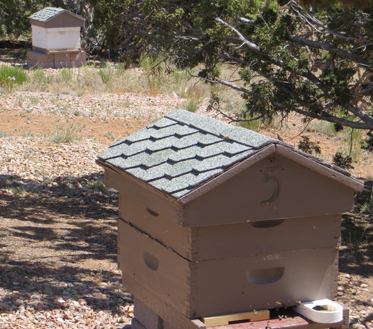 |
|
2011 |
2016 |
 |
The Beginnings - 2010
I enrolled in the beekeeping course at Ecoversity in Santa Fe in the spring of 2010. I received my first hive and box of bees w/queen. I later purchased another hive from a local source and another box of bees/w a queen.
Several of us rescued a wild hive of bees from an Eldorado resident. The wild bees had built their hive on the underside a portal. It took several of us to get it down and place it in a hive to be transported to Eldorado Windy Farm.
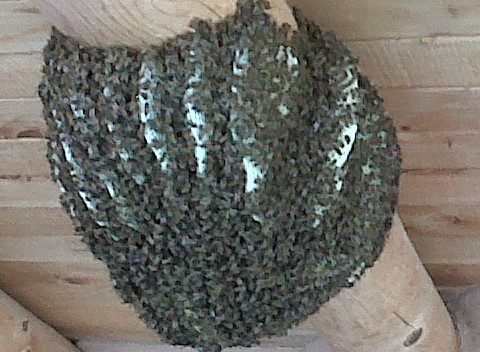 |
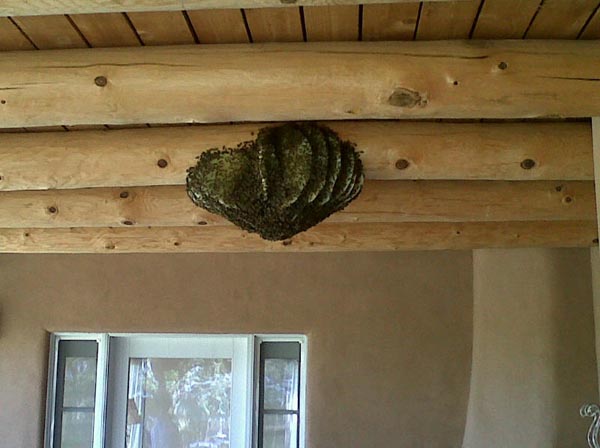 |
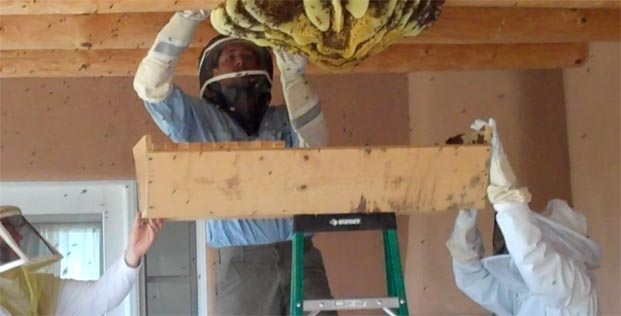
The Pollen Study
In order to determine the plants that my bees visited at different times during the flowering season I collected data on the plants that bloomed at Eldorado Windy Farm and those that bloomed in the surrounding area of the Eldorado neighborhood within a one-half mile radius of the hives.
2011 Activities
2011 was a successful year in that I was able to move enough topbars filled with honey from the stronger hives to the weaker hive so that the bees in all three hives would have 14 topbars in each hive for the winter. All additional topbars that were filled with honey were collected, the honey extracted and the comb melted into usable wax which I collected using a homemade solar wax melter made from a Styrofoam cooler.
In all, almost ten pounds of honey was collected and about a pound of wax from the bees in 2011. Most of the The honey was saved and fed to the bees in the spring. In the summer I made some products with the wax that I sold at the Eldorado Farmer's Market along with 1/2 lb. bags of the wax that I melted.
2012 Activities
| Winter | Spring | Summer | Fall |
Winter
I went into all 3 of my hives and found living bees only the wild one (#1). The queen in that hive was introduced from Zia Queen Bee two years ago. The other two were full of dead bees that didn't make it through the winter. This being the case I will order 3 boxes of Russian-Carniolan bees from Honeybee Genetics to be delivered on April 25. At the end of this season I will not have enough bees to collect honey for myself, but I will re-distribute any that I have to each hive for next winter. I cleaned out one of the hives and will process the honey and the wax. I will do the other one at a later date.
Spring
February - Checked all of the bees. Hive #5 that was split had 3 opened and empty emergency queen cells and one unopened one. #2 is growing strong eventhough the split was taken from it. I moved another bar of brood from #4 to #3. #1 is still not as strong as it should be, but is doing well.
April - I checked all of the beehives. The old one that made it through the winter is doing fine with lots of capped honey and brood. Of the three new ones only one seems to be thriving. The other two seem weak. I will call Honeybee Genetics to see what they think I should do. After all, it has been only 11 days since they were introduced into their hives.
Obtained pollen to study from the bee hive for the first time (Pollen from the hives). Bees seem to be doing well in the hive bringing in pollen and nectar from ours and neighbor's flower gardens and trees. There are still no abundance of wild flowers in the surrounding one-half mile radius from the farm. There is capped brood in the hive as well, but no queen or drone cells present. Many of the fruit trees have finished blooming and some are setting fruit.
May - When I checked the three new bee hives I found that only one of them had capped brood. The other two will dwindle down soon if they don't have a queen to increase their numbers. I ordered two new queens for the other hives and they were delivered on Friday. I introduced them when they arrived and hopefully they will be accepted. I will add a comb of brood to each of the hives from my stronger ones next week.
On Saturday I gave my presentation "Fruit Trees and Bees" at the La Tienda shopping center to about thirty participants. They all seemed to like it and asked lots of questions.
June - Checked the bees. The old hive and one of the new hives are getting stronger. One of the other new hives that was re-queened is beginning to thrive, but one is still pretty weak. I have to decide what to do with it next week (add brood with eggs & larvae, combine it with a stronger hive or leave it alone.)
Summer
June - I only observed the bees from the outside of their hives this week. All hives have bees flying in and out to bring in nectar and pollen. One of the hives (#3) still seems weak. I will know what to do with it next week when I go into it.
July - I combined the bees from hive #3 into hive #1 on Tues. 17th. They were both week hives and I am hoping that the combination will become stronger before the winter. They still have until October to increase their numbers. Went into all 5 hives this week. They are all doing alright. Two very strong, split doing well, the two weak ones are still weak, but doing ok.
August - The bees in hives #2 & #4 are doing well. I removed three bars of comb from #5 that were inserted when I combined them with bees from #3. I also put in some crystallized honey, since they didn't seem to have gathered nectar enough to make enough honey.
September - The bees in hives #2 & #4 are still doing well. The temperatures are getting in the 40s now at night, so they are not as active as in the past. The bees in #5 are still alive but are not thriving. We will see what happens to them over the winter although I fed them lots of crystallized honey from last year.
Fall
December - The bees from all three hives came out on sunny days that were 50 degrees are higher. After the weather got too cold they stayed in and will not be out again until the weather warms up.
September - The bees in hives #2 & #4 are still doing well. The bees in #5 seem to be doing better. I went into all the hives this week and decided to move a bar of brood w/honey from #2 to #5. They are bringing in lots of chamisa pollen and nectar from other sources.
October - The bees in all three hives are doing well. They are all making brood and putting up capped honey and pollen. The bees in hive #2 have 17 top bars with capped honey and brood. The other two have 5 - 6 bars. I will let them continue to build up their stock until October 22 when I will take all but 14 bars from hive #2 and redistribute the honey into the other two hives for the winter (maybe keeping one for myself). I am also planning to put the Styrofoam covers on all the hives at that time for the winter.
I went into all three hives for the last time for the year on October 22. Hive #2 had 15 bars with brood and honey. I took one of the honey bars and moved it to the front of hive #5 and I harvested another for my own use leaving them with 13 full bars. I added a pint of crystallized honey to hive #5 to add to the one that I added previously. Hive #4 had 7 bars of brood and honey. I added two pints of crystallized honey to it for the winter. I closed up all three active hives and put on their Styrofoam covers for wind and cold protection during the winter. Hopefully all three will make it until spring!
The bees have been successfully "put to sleep" for the winter. Their covers have all been placed on the hives and they only come out on sunny days when the daytime temperatures are above 50 degrees. Then only for water, since there are no flowering plants available.
2013 Activities
| Winter | Spring | Summer | Fall |
2014 Activities
Since the original collection of bees, several 3lb. boxes of of bees with a queen have been purchased from various sources outside of New Mexico. Unfortunately all of the purchased hives have not made it through the winters. In 2013 a small swarm was noted not far from the original hive. I tried to collect it, but the bees absconded after a day in a new hive.
The bees in the hive that was superseded are doing well into the winter of 2014. I left them with 17 bars of honey/brood. Much more than what they would normally use.
Two more 4 lb. boxes of bees were purchased from A-Bee Honey. They were delivered on April 20. I asked for queens that had made it through the winter. On May 13-14 the temperature reached 30 and 29. All of the new bees died! They evidently were brought from California where they were not used to the cold.
On May 30 I split my good hive and split the hive from the neighbor across the street each with 4 combs of brood. I feed all of them sugar water (2c H2O - 2 1/2c sugar) until there were enough flowers blooming in the neighborhood to sustain them. Both hives did well into the fall and will be left with at least 14 bars of honey and brood for the winter.
2015 Activities
January
January in northern New Mexico is always a cold, windy month. This year January was exceptionally dry. There were a couple of good snows in December, but not in January. Some of the bees were coming out on warm days (above 50 degrees), but otherwise there was little activity.
February
Checked my three hives of bees and found one to be dead (the split from my oldest hive) and two to be doing fine (the old hive and the split from the neighbor across the street). I put in 2c 1/1 sugar water into each at the beginning of the month. Bees are bringing in yellow pollen from somewhere. Usually the only thing blooming in Eldorado this early is the Siberian elm, but the ones around the house are not yet in bloom. Checked bees at the end of the month and found that the old hive needed sugar water added, the split had plenty of sugar water and comb honey left from earlier in the month.
March
Checked bees every two weeks adding sugar water when needed. The split hive was doing the best so far. Other older hive is ok, but not as good as the split.
April
Checked bees on the 12th and found the older hive without a queen. I put in one bar of brood and honey from the split hive hoping that they would make a queen with the brood. Took out all empty sugar water containers from both hives.
May
On the 21st I checked both hives. The one without a queen had evidently made one and she had laid eggs and there were larvae present. I fed both hives sugar water.
June
Checked both hives on the 3rd. Split from across the street doing very well. Other has few bees and has been robbed. However, there were two bars of brood. Took sugar water out of both hives.
July
On the 3rd I got a nuc Langstroth hive from A-Bee Honey from Edgewood. The nuc has 6 bars of brood and honey and is doing very well in its new environment. I added two more bars to the brood tall super and a 2 bar feeder. I additionally added a medium super with 10 bars on the 17th. I was saved by a beekeeping friend who gave me the base, a short super, lid and roof that he had made.
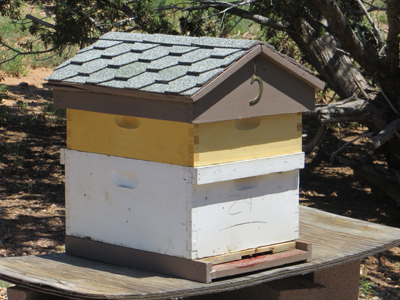
On July 26 the bees from the split hive swarmed to the juniper tree next door. They had been bearding at the front of the hive for the last several days. Right before they swarmed they covered most of the front of the hive.
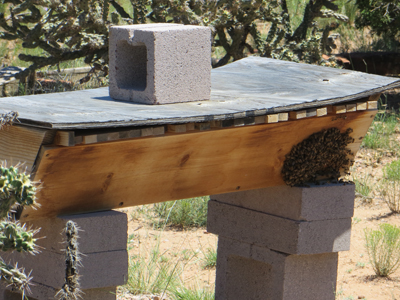 |
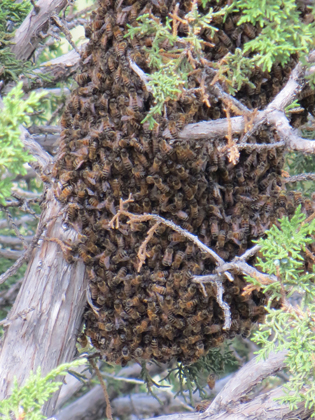 |
Bearding at hive entrance before swarming |
Swarm in neighbor's tree |
I checked all three hives on the 13th. The two topbar hives have 15 bars honey and brood each and the bees in the Langstroth have built out one of the two new frames in the tall super and have started to fill in one bar in the medium super.
October
Last look inside the hives for the year. All of the 3 hives look good going into the winter. Put 2:1 sugar water in all of the hives. Moved 2 honey bars in topbar hives from the back to the front of the hives for the winter. Collected no honey.
November
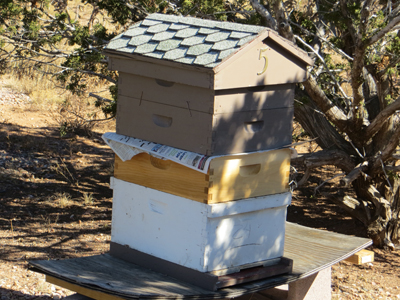 |
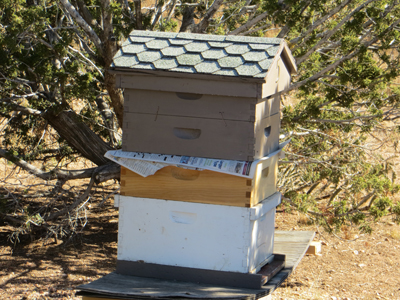 |
On the 10th a friend who has a hive wanted to know if he could combine his bees with mine. He was afraid that his were too weak to make it through the winter. I agreed to take them so he brought them to my bee yard in two shallow supers full of bees with ten frames each. The day before he found and killed his queen. We placed them on top of my Langstroth hive with a double sheet of newspaper between them. In a few days they should eat their way through the paper and join my bees. This should give them time to get used to my queen's pheromones. They immediately found a hole on the top of the hive and began flying in and out. Now both hives will have to adjust to each other before the freezing weather begins.
2016 Activities
January
This January has been exceptionally snowy and cold because of El Nino. On the 16th I saw bees out flying. Snow was on the ground, the sun was shinning brightly and the temperature got up to 39.6 degrees. Upon examination, the bees from the the older hive were the only ones not out. The bees from the split and the Langstroth were both flying. By the 29th they were all flying.
March-April
Unfortunately both of the topbar hives died after coming out of the winter. There were a few bees left in one of the hives and I observed a lot of activity around the door. It turned out to be robbers! The hive had become so weak that bees from other hives were tearing into the combs and eating the stores. After five years of getting and loosing hives I have decided to only keep 3 topbar hives. These hives will be stored until I either catch a swarm or get a split from someone else. I still have one Langstroth hive left, but it has lost its queen. I will replace her if I can find one to purchase.
May
Bought a nuc from A-Bee Honey and installed it in a second Langstroth. Also, replaced the queen in the original Langstroth. Still no topbars in bee yard.
July
The bees in the 1st hive killed the queen that I introduced in May. On the 7th I checked both Langstroth hives. The first hive had bees, but still no sign of a queen or brood. I decided to combine both hives. Now I have one hive with a deep brood nest, a medium and and two shallow supers. I separated the two top supers from the bottom ones with newspaper. They will eventually eat through the paper and all of the bees will be combined. Hopefully they will store enough honey for the winter.
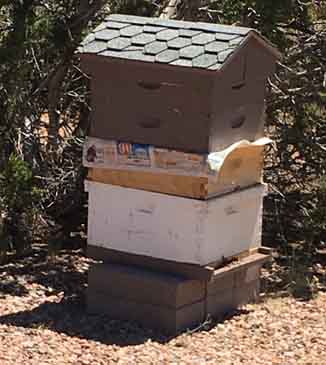
September
The bees are doing well in the one Langstroth hive. I gave them some 2-1 sugar water food and put on one more shallow super. The hive going into fall has one deep, one medium and 2 shallow supers. They will have all of the asters and sunflowers for foraging until the first frost next month. By then their numbers should begin to dwindle to the winter amount.
2017 Activities
Cheked the bees on January 12. They were all dead. I will not replace them. The hive is being robbed out by neighborhood bees. Maybe a swarm will move in. No such luck! By March I had either given away or sold all of my beehives.
Constructing a Solar Wax Melter
Sugar Water Feeder for Topbar Hives
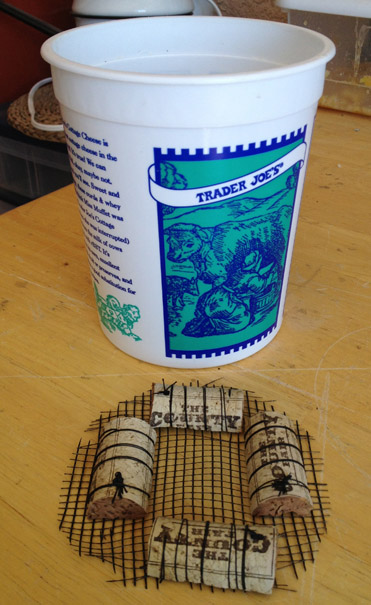
This is a sugar water feeder that I devised to place into my hives when honey supplies are low. The corks float the screen above the sugar water solution. I used a 1:1 (by weight) sugar/water solution (2c water to 2 1/2 cups of sugar. (The corks are placed down in the container.) A bigger container might be necessary to feed a larger colony.
Introducing Bees to a New Hive
CATALOGUE OF PLANTS AT ELDORADO WINDY FARM THAT ATTRACT HONEYBEES
by Bloom Date
Honeybee Mentor Program
I was very fortunate in 2012 to have been selected to be a mentor in beekeeping to a student, Eric, from the Monte del Sol Charter School. The school requires every student to be enrolled in a mentorship program in an area of their interest as one of the graduation requirements. Eric spent an average of two hours each week with me during the mentorship course in the fall and spring. Activities included inspecting a hive once before it got too cold, watching several educational movies about bees, making bee related products, attending a meeting of the Sangre de Cristo Beekeepers Assn., going on visitations in Eldorado, Penasco, Dixon and Espanola to see other beekeeping operations, answering beekeeping questions at the bee keeping table at the annual Master Gardener's Garden Fair.
Interesting Bee Links
| Wikipedia- Beekeeping | Beekeeping 101 |
| Gardening Channel (Raising Bees) | Dadant- a good source for supplies |
| Brown's Downtown Bees | Honey - What is it? |
| Creating Pollinator Gardens |